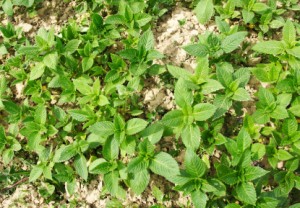
Herbs become invasive in one of two ways. Some freely scatter their seeds, that seem to sprout with ease even in the most inhospitable conditions. Others send out rhizomes (root-like stems) that meander along just under the soil's surface; sprouting new plants as they go. Both are highly efficient ways to overrun your garden and choke out existing plants. Here are some ways to keep these invasive herbal companions in check.
If you find that one of the invasive herbs in your garden has managed to escape, dig up the unwanted seedlings, making sure to remove the entire root system. Then sift through the soil with a digging fork to make sure you get any leftover pieces. Keep an eye on the area for several months, and either dig out any plants that reappear or clip them off at soil level and smother them for several weeks with a heavy layer of newspaper or a large, flat stone.
Catalogue Clues: When shopping for herbs in garden catalogs, invasive herbs should come with a warning (mint in particular), but they usually don't, so you'll need to do your homework as well as learn to read between the lines. Plant descriptions such as 'carefree", "vigorous", "establishes quickly", or 'grows anywhere" may be code for invasive tendencies. When acquiring herbs locally, consult other gardeners, local nurseries, and your local extension agent about herbs that are invasive in your area.
This page contains the following solutions.
Each year millions of dollars are spent, and tons of herbicides are applied, in what is sometimes a futile attempt to combat the spread of invasive plants. Here is what you need to know about the invasive plant problem and what you can do to help.
Many plants, especially herbs, are very invasive and will spread and quickly take over your garden. To prevent this, place the plant, like this spearmint, in a container.
When planting a plant that is liable to take over your garden, it is best to get a small plastic bucket and set it into a previously dug hole.